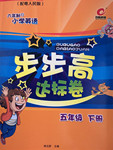题目内容
Full advantage should ______ technology to help people live a better life.
A. take in B. take of
C. be taken in D. be taken of
D
【解析】
试题分析:考查动词短语。句意:为了帮助人们过上更好的生活,要充分地利用科学技术。根据短语take advantage of sth,主语是advantage,应用被动语态,故选D项。
考点 : 考查动词短语

练习册系列答案
 步步高达标卷系列答案
步步高达标卷系列答案
相关题目